 Let’s stick together
Let’s stick together
‘You are only as good as your last job’ is a phrase that is often quoted and nowhere is it more apt than in the sign industry. A single bad experience can lead not only to the loss of the customer concerned, but can significantly damage a sign-maker’s reputation, as that customer expresses their dissatisfaction to other businesses. One particular area where sign-makers can come unstuck, if you will excuse the pun, is in their choice of bonding tapes and adhesives. Get it wrong and not only can it lead to a failed job, but potentially much more serious and damning consequences.
This is an issue that has rebounded around the UK sign industry across 2016, with failed adhesives causing deaths, injury, and hospitalisation for pedestrians caught when signs have failed. Going from this extreme to a more day-to-day concern, using the wrong adhesive or taping system can simply make sign manufacture far more hassle than is needed, and result in a lower quality finish. Indeed, the pain caused to your production and staff of using a solution that ‘works just’ instead of ‘just works’ is easily avoided, and that is why I have chosen to try and detail for you dear reader a snap shot of the adhesive and tape technology that could make a significant difference to your business. It might not be the sexiest of subjects to write about, but if I can help you identify the perfect adhesive for the job in hand, then it will have been very much worthwhile.
Creating a firm bond
One of my first stops on this tour of this core industry sector was Kent-based Eurobond Adhesives, which has over 30 years’ experience of supplying sign-makers with high performance adhesives and tapes, and its Penloc range of toughened structural acrylic adhesives, which is specifically designed for sign-making applications, is used and trusted by thousands of sign-makers throughout Europe.
Penloc will bond most metals, composites such as Dibond, plastics, wood, glass, ceramics, and GRP in any combination. Available in 12ml, 50ml, and 400ml cartridges, Penloc is suitable for bonding sign channels to faces, bonding locators or bighead fasteners, making sign trays, monoliths or general metal and plastic fabrication including built up letters. It can also be used ‘bead on bead’ without using mixer nozzles for some applications.
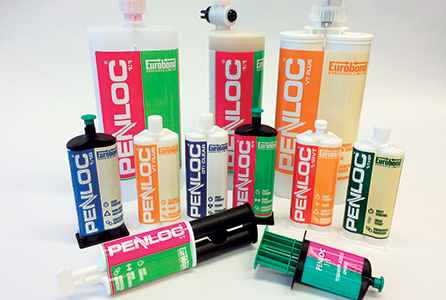
Eurobond’s Penloc range of toughened structural acrylic adhesives is specifically designed for sign-making
For bonding acrylic, polycarbonate, metal and glass combinations, Eurobond recommends its Vitralit range as an ideal solution. Typical applications include fabricating acrylic display cases, leaflet dispensers, point-of-sale products, acrylic sign, and even trophy manufacture.
“Our UV adhesive range offers ‘cure on demand’ capabilities,” elaborates Simon Dearing, Eurobond Adhesives’ managing director, adding: “If you make a mistake you can simply pull the workpiece apart in the early curing stage, peel off the adhesive and start again; no waste acrylic or spoilt workpieces. It is far superior and more user-friendly than solvent weld adhesives. In addition, our UV adhesives will give optically clear bond lines with no crazing, stress cracks or air bubbles.
“Using the correct grade of adhesive and adhesive tapes can make or break a company’s hard earned reputation,” affirms Dearing, adding: “So our ‘Six’ series tape is an ‘ultra-strong’ universal bonding tape that has extreme high strength, resists all weathering and will bond just about any material combination. It is also available in a clear version for applications where an invisible bond line is required.”

Three Eurobond products were used to create this stunning casino signage: Penloc VT Plus structural adhesive for the built-up letters, EB6100G acrylic tape for bonding stiffener bars to the back of the letters, and Clear Fix flexible adhesive to bond and seal the lighting tracks
For more than 15 years, Lancashire-based Innova Solutions has worked in partnership with leading sign-makers and material manufacturers to develop a range of cutting edge, strong, reliable solutions for the ever-changing bonding needs of the industry.
“Over the years we have seen a move towards lighter, thinner and more environmentally sensitive substrates, all of which have to be bonded, with confidence in the final product, on a repeat basis,” comments Innova’s managing director, Glenn Dunleavy.
This challenge has been met head on by Innova by way of their Nova Bond high strength foamed acrylic adhesive tapes, Nova Weld two-part structural adhesives, and a range of ancillary products to complement these flagship ranges.
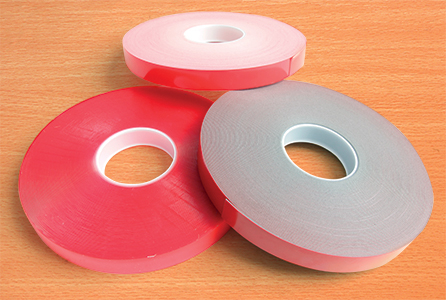
Novabond high strength foamed acrylic adhesive tapes have been designed to meet the challenges presented by the move towards lighter, thinner, and more environmentally sensitive substrates
Recently Innova was commissioned by one of the sign industry’s leading companies to test adhesion of their Nova Bond high strength bonding tapes to a wide range of sign-making substrates including aluminium, stainless steel, ACM, foamed PVC, acrylic, powder coated aluminium, polycarbonate, and glass. Historically, tapes have been tested primarily for adhesion to stainless steel, which bears little relevance to most sign industry applications. During the adhesion tests substrates were bonded in a configuration of both similar and dissimilar combinations with Nova Bond tapes and another key tape brand.
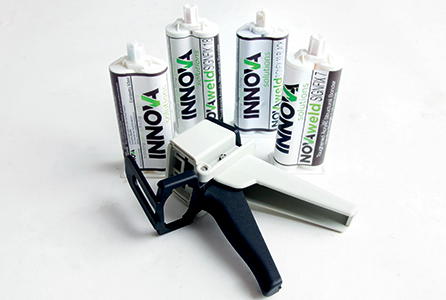
Nova Weld two-part structural adhesives from Innova Solutions will bond metal, acrylic, and nylon locators to ACM panels without any read through and distortion to the front face of the sign
“I’m delighted to say that the independent test results demonstrated that Innova products out-performed the competition in over 75 percent of cases,” reveals Dunleavy, adding: “These test results are available for inspection and Innova Solutions is happy to discuss them in more detail with sign industry companies.”
Other recent innovations include two-part structural adhesives that will bond metal, acrylic, and nylon locators to ACM panels without any read through and distortion to the front face of the sign, a range of tapes and adhesives that will bond metals prior to the powder coat process, and dichloromethane free plastic welding adhesives.
In addition to recent product developments, Innova has a proud association with Mark Felix, eleven times World Strongest Man competitor. “Mark’s legendary grip strength, power and performance is synonymous with Innova’s proven track record of trust and reliability within the sign industry. So, as well as rigorous independent third party testing of all new product developments, these new products will now have the added challenge of passing the Felix test,” concludes Dunleavy with relish.
Make your reputation stick
When considering which way to bond or fix a sign, it is vital the correct product is used in the right way, as the choice of materials can make or break a sign-maker’s reputation. However, with ever changing sign-making materials, this can sometimes be a challenge.

It is vital for the sign-maker to uphold his reputation and use products he has faith in ”
“INDASOL understands that not every sign is made or fixed in the same way and we have developed our range of technical tapes and adhesives to cater for every application,” comments Paul Robinson, owner of INDASOL, adding: “And we are always happy to advise.
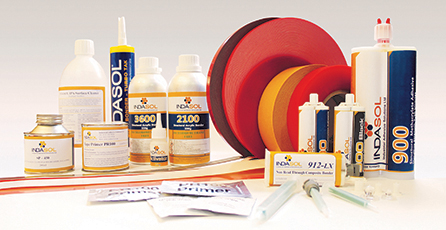
Recognising that not every sign is made or fixed in the same way, INDASOL has developed technical tapes and adhesives to cater for every application
“When we work with our customers, we aim to understand the demands placed on the fixing solution, such as weight, materials being used, environment etc. All of these factors have a huge bearing on the final finish and of course safety of the installation.
“We offer products that are designed to cope with the most demanding applications, bond to difficult surfaces and withstand what Mother Nature throws at them. For example, some of our products are designed to expand and contract at up to four times their own thickness and cope with temperatures as high as 260C and as low as -80C.”
The INDASOL range of high performance bonding products is available off the shelf and can also be tailored to specific requirements. However, Robinson offers a word of caution: “The market is flooded with cheap products that on the face of it look the same but, when put to the test, fail after a short time. It is vital for the sign-maker to uphold his reputation and use products he has faith in.”
Innova’s Dunleavy concurs: “For the sign-maker the use of the right tape or adhesive for a particular job is crucial and, given the events of recent years, critical.”
Considerations include factors such as initial grab or holding power, ultimate bond strength, and allowance for differential expansion between dissimilar substrates when the sign is in situ. These criteria also have to fit with the desire for the finished sign to be as aesthetically pleasing as the design demands.
Dunleavy warns: “Many of these considerations can be overlooked at your peril. When Innova first entered the market there was much ambiguity regarding correct product selection, with opinions differing greatly from region to region.”
As a nationwide supplier to the sign industry, Innova addressed this by offering free onsite surveys, where day to day as well as bespoke applications were assessed, offering sound advice on product selection and application method. This was backed up by credible independent testing of their products in conjunction with customer’s substrates and useful ‘how to’ guides. Their aim was to ‘make life easier’ for their customers, a strapline that they still stand by today.
“With the ever changing needs and demands of the industry come new challenges,” continues Dunleavy, adding: “and sign-makers can rest assured that we will continue to work with our partners to develop bespoke solutions that will satisfy these challenges and ensure that their products are securely and reliably bonded, ensuring that our partners’ reputations enjoy the same high standards as the signs that they manufacture.”
Sticky advice
With over 30 years’ experience in the field, Spandex is another major trade supplier to the sign-making and display industries, representing leading brands in the industry, and continuously introduces new
cutting-edge materials, accessories, and equipment to help turn creative ideas into competitive solutions.
“With a complex market offering, knowing what tape to use and when to use it can be overwhelming, but using the right tape for the job provides multiple benefits that will help maximise both productivity and profitability but most importantly keep your hard-earned reputation intact,” says Spandex category manager, Chris Holmes.
He continues: “In addition, selecting the right tape can provide improved reliability, increased confidence, increased application efficiency and ensures you are selecting a cost-effective tape. Our new range of double-sided tapes consists of products from the some of the world leaders and caters for multiple applications; and our new Tape Selection Guide provides customers with all the information they need to help guide them through the tape selection process.”
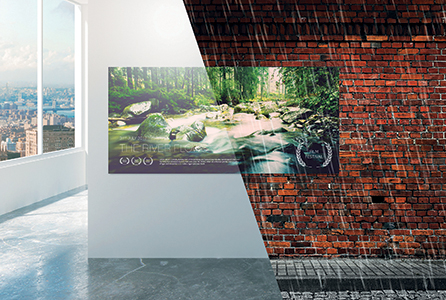
Double-sided bonding tape from Spandex was used in creating this finished sign
Spandex offers a brief guide to what a sign-maker needs to consider when selecting a tape for a specific application, whether you are looking to mount a panel, seam a banner or make an acrylic box. These include considering the surface it is being applied to, considering factors such as plasticisers. Another important element is the application itself, understanding temperature ranges, and how curing times can be affected in this regard. Load is another vital area to consider, as tapes with high internal strength and high shear/cohesive strength will help with heavy weight loads and foam carriers can help absorb friction or movement. And finally environmental factors and how they will affect adhesive integrity is another very important area to consider.
Historic strengths
Now, no consideration of the runners and riders in this sector is complete without considering the grand-daddy that is 3M—which has been pioneering adhesive technology for 35 years. Indeed, 2016 marks the 35th year of its VHB Tapes, and to celebrate it has launched its next-generation product, GPH.
Jennifer Gould, UK product manager for foam tapes and fastening systems 3M IATD (Industrial Tapes and Adhesives Division), tells us all about VHB's most innovative moments and how, after more than three decades, the most exciting innovations to date are just being released.
“True innovation isn’t a single moment, but a continuous process. Few products exemplify this like 3M's VHB Tapes, which broke brand new ground in the 1980s, and continues to do so today.
“Newly released, the GPH Series is the latest to arrive on the market. This, the next generation of VHB Tape, offers more versatility, ease of use and greater functionality than ever before.”
The VHB story begins with the first tapes, called 4945 and 4965, which were launched in 1981. Ultimately, these innovations broke the traditional barriers of engineering and manufacture, removing the need to use mechanical fixings such as rivets and screws. This not only gave manufacturers the freedom to bond together different materials, but also to improve productivity (being faster to use and lighter on preparation than traditional mechanical fixtures) and even enhance aesthetics.
As VHB became better established, customers began to want to take advantage of its fast bonding, aesthetic benefits and production efficiency in a wider variety of applications. So, in the late 1980s and early 1990s, the range of VHB Tapes expanded significantly. This included tapes that suited a host of new materials and low temperature applications, and available in varying thicknesses. Arriving in 2002, the 59 Series was the first post-powder coat tape. This innovation enabled manufacturers to effectively bond materials that had been powder coated, as well as other painted surfaces, without having to treat the substrates in question first, saving time and therefore boosting production speed efficiency.
Across 2010 and 2011, VHB celebrated its 30th anniversary, and it did so with the launch of a brand new product—the RP Series. This new range of all-acrylic tape was designed to provide the characteristic strength, conformability, and versatility of the VHB range at a cost-effective price.
Gould continues: “It may be 35 years since the ground-breaking creation of VHB, but 3M continues to innovate. Six years after the launch of the last VHB product, the next generation of RP Tape is being released—and it's one that promises to pair cost-effectiveness with outstanding performance.”
O Factoid: The earliest use of adhesives was discovered in central Italy when two stone flakes partially covered with birch-bark tar and a third uncovered stone from the Middle Pleistocene era (circa 200,000 years ago) were found. This is thought to be the oldest discovered human use of tar-hafted stones—(Wikipedia) O
A double coated acrylic foam tape, the GPH (General Purpose High Temperature) Series solves the challenges of temperature resistance and multi material bonding. What is particularly interesting about this new tape is its ability to perform multiple jobs, meaning that manufacturers potentially only need one tape, which they can then use to complete a host of bonding tasks.
Indeed, GPH Tape builds on all the advances made since the initial creation of VHB, addressing contemporary construction needs in the process. Through 'quick stick' technology and fast liner release, assembly is quick and simple, with high initial tack creating incredible initial handling strength and bonding on contact. And, according to 3M, there is no need for curing and the tape can be cut into precise shapes, thus saving time, space, and costs.
The product also has a high short-term temperature resistance of up to 230° C, making it ideal for bonding even in tough temperature applications like pre-powder coat or liquid painting.
So, with all that information now at your disposal, getting a firm grip on your reputation can clearly involve some sticky decisions—but the wealth of advice and help available from specialist manufacturers and suppliers will help you ensure that the signs you produce will stand loud and proud for the duration.
Your text here...